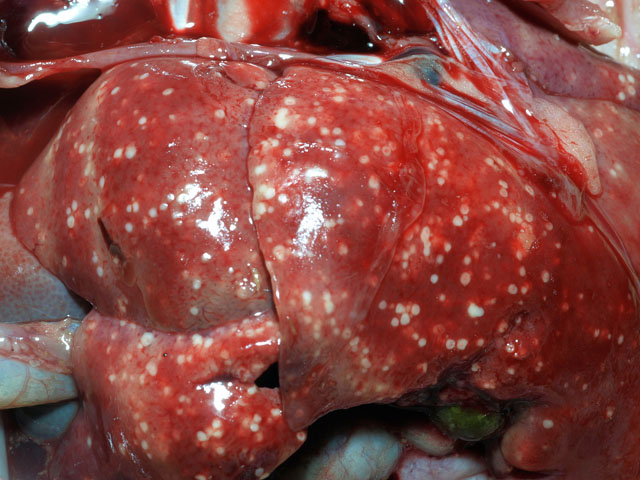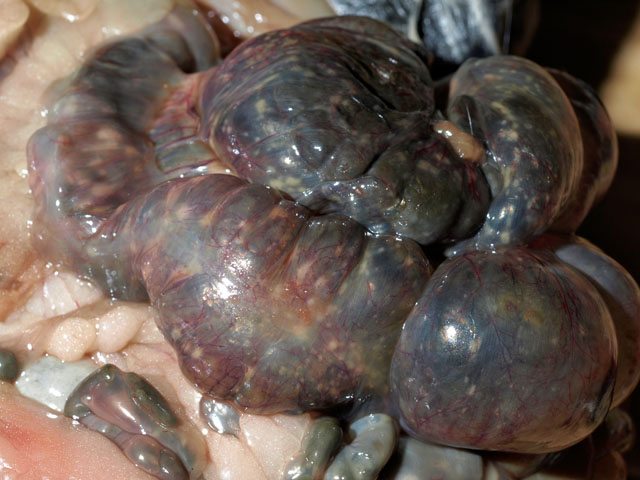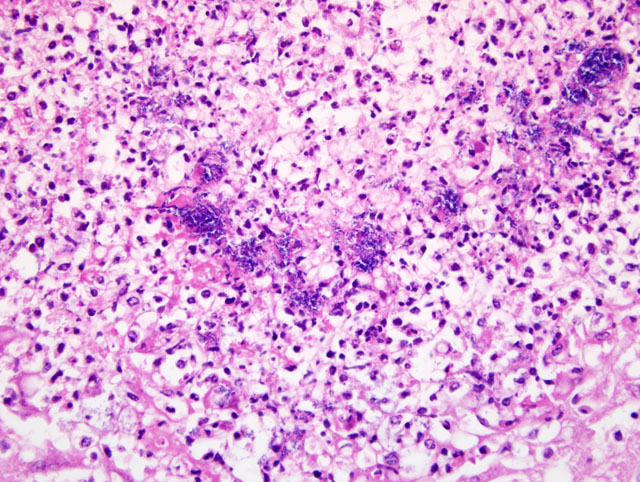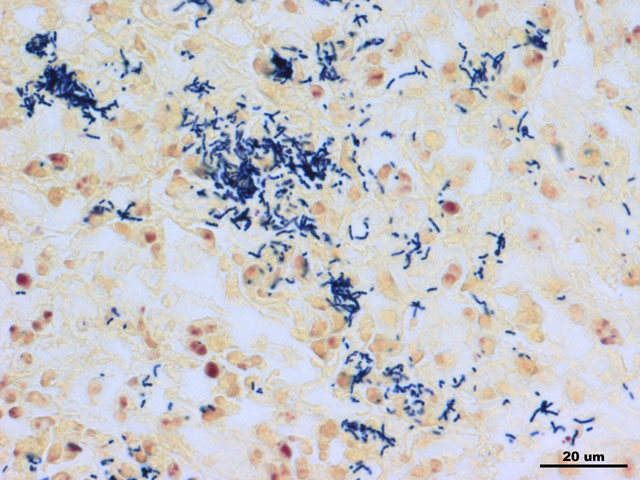Signalment:
Adult, female,
Chinchilla lanigera, Chinchilla14 of 100 adult fur-ranched chinchillas died over a one-week period. Clinical signs prior to death include listlessness, loss of balance, ataxia.
Gross Description:
Six animals were submitted for postmortem, all with similar gross lesions including multiple random 1-4 mm white foci visible on the capsular surface and throughout the parenchyma of the liver (
Fig. 3-1); similar foci were visible through the serosa of the small intestine, cecum and colon (
Fig. 3-2). Cecal and colonic content was dry and inspissated.
Histopathologic Description:
Scattered throughout the liver are random multifocal areas of parenchymal necrosis and inflammation, characterized by a central zone of cellular debris, fibrin exudation and marked neutrophil infiltration, with scattered aggregates of small rod-shaped bacteria (
Fig. 3-3); lesser numbers of lymphocytes and histiocytes are evident around the periphery of some foci. Moderate numbers of hepatocytes, predominantly in zones 2 and 3, have one or more large clear cytoplasmic vacuoles (lipid), and there are occasional fibrin thrombi in hepatic vessels. Tissue gram stains (Brown and Brenn) reveal large numbers of gram-positive rod-shaped bacteria in the foci of necrosis (
Fig. 3-4).
Similar foci of mucosal to transmural necrosis are evident in sections of small intestine, cecum and colon, and there is fibrinosuppurative meningitis evident in sections of brain (tissues not shown).
Morphologic Diagnosis:
Multifocal random hepatic necrosis and microabscessation with intralesional gram-positive rods, compatible with
Listeria monocytogenes infection
Lab Results:
Listeria monocytogenes was isolated from lung (1+) and liver (4+).
Condition:
Listeria monocytogenes
Contributor Comment:
Listeriosis is a common disease of ranched chinchillas (2,6) first reported by MacKay et al. in 1949.(4) The disease is caused by
Listeria monocytogenes, a facultatively anaerobic, gram-positive, rod-shaped bacterium that is considered part of the normal microbial flora in ruminants, and can persist in the environment as a plant saprophyte on decaying vegetation.(1)
Listeria is also a potential pathogen, capable of causing three distinct clinical forms of disease: septicemia (principally in monogastric animals), encephalitis or abortion (principally in adult ruminants). While a wide range of animal species can be affected, chinchillas are considered highly susceptible to the visceral septicemic form of disease. Ingestion of contaminated food (such as pellets or hay contaminated with rodent, chicken or ruminant feces) can result in intestinal infection, with bloodborne dissemination to liver causing multifocal necrosis and abscessation, with subsequent septicemia and systemic spread to various organs including lymph nodes, lung, spleen, and brain.
JPC Diagnosis:
1) Liver: Hepatitis, necrosuppurative, multifocal, moderate, with numerous bacilli, Chinchilla (
Chinchilla lanigera), rodent
2) Liver, hepatocytes: Vacuolar change, lipid-type, diffuse, mild
Conference Comment:
Listeria monocytogenes is an important pathogen of not only animals, but also humans, and is well known for its ability to grow in a wide temperature range to include refrigerator temperatures. Because of this ability, outbreaks of food-borne listeriosis occur periodically in the United States. In veterinary medicine, it may be most notorious for its ability to grow in farm feeds, specifically silage, and cause subsequent clinical disease in cattle unlucky enough to be fed this tainted meal.(3)
L. monocytogenes produces a hemolytic toxin that adds to its virulence which distinguishes it from other species that are nonpathogenic.Â
L. monocytogenes can also survive within macrophages and thus hide from the host immune response. A strong cell-mediated immune response by the host is essential to prevent development of clinical listeriosis.(3)
The three clinical syndromes of listeriosis -- septicemia, abortion, and encephalitis -- rarely overlap, thus suggesting a separate pathogenesis for each. The abortion syndrome usually occurs in ruminants in late gestation and probably gains access to the uterus and fetus via the bloodstream. The septicemic form has been reported in calves, foals, and aborted fetuses and manifests as numerous miliary microabscesses in the liver and to a lesser extent in other organs. In the encephalitic form, contaminated silage is fed to ruminants and the organism invades the oral mucosa through abrasions and enters the trigeminal nerve. The bacteria use the axon as a highway to gain entry to the brain.Â
Listeria monocytogenes has a predilection for the brainstem and causes microabscessation that can sometimes be seen grossly. Histologically, these areas are characterized by either small aggregates of neutrophils, or more commonly small glial nodules are observed.(5)
Other domestic species rarely get listeriosis, but when they do the clinical signs and disease progression follow a similar pattern.(5)
References:
1. Donnelly TM: Disease problems of chinchillas.Â
In: Ferrets, Rabbits and Rodents. Clinical Medicine and Surgery, eds. Quesenberry KE, Carpenter JW, 2nd ed., pp. 255-265. Elsevier Saunders, St. Louis, MO, 2004
2. Finley GG, Long JR: An epizootic of listeriosis in chinchillas. Can Vet J
18:164-167, 1977
3. Greene CE: Listeriosis.Â
In: Infectious Diseases of the Dog and Cat, ed. Greene C, 3rd ed., pp. 311-312. Saunders, Philadelphia, PA, 2006
4. MacKay KA, Kennedy AH, Smith DLT, Bain AF: Listeria monocytogenes infection in chinchillas.Â
In: Annual Report of the Ontario Veterinary College, Guelph, pp.137-145, 1949
5. Maxie MG, Youssef S: Nervous system.Â
In: Jubb, Kennedy, and Palmers Pathology of Domestic Animals, ed. Maxie, MG, 5th ed., pp. 405-408. Elsevier, Philadelphia, PA, 2007
6. Wilkerson MJ, Melendy A, Stauber E: An outbreak of listeriosis in a breeding colony of chinchillas. J Vet Diagn Invest
9:320-323, 1997



